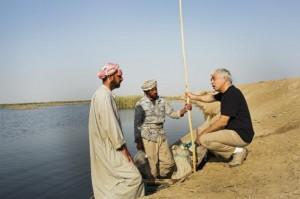
During Saddam Hussein’s reign of terror, his environmental transgressions were manifold. Among them were chemical warfare, continued oil extraction, and setting wells in Kuwait on fire, all of which were well publicized. Perhaps less well known was the draining of the Fertile Crescent, the birthplace of agriculture. In Iraq, some of the most fertile land in the Middle East, Hussein diverted the flow of the Tigris and Euphrates rivers in order to drain massive wetlands and flesh out rebels. This act of environmental destruction turned out to be the ultimate in unsustainability. Marsh Arabs who live in the drained wetlands suffered economically.
With the fall of Hussein a decade ago, Marsh Arabs started to reclaim their wetlands by breaching the earthen walls constructed to hold the water back. It wasn’t until Azzam Alwash, an expat living in Los Angeles where he earned his civil engineering degree, returned that an orderly approach to the reclaiming of wetlands took place. Alwash had grown up in and around the wetlands, where his father worked as a hydrological expert during the 1960s.
With the return of the marshes, people’s dignity, respect, culture, and way of living returned. In the video clip below, Alwash explains how the reeds and fish returned shortly after the restoration began. Reeds serve multiple purposes in the community,. They serve as the main building materials for structures across the region. Additionally, they provide habitat for the returning aquatic wildlife.
For his work assisting the Marsh Arabs, Alwash was awarded the Goldman Environmental Prize.
[Image source]




